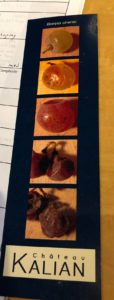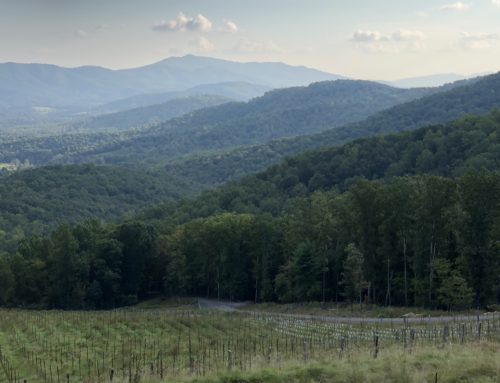Term–
Noble Rot
A type of fungus that shrivels and decays wine grapes. Used in Sauternes and Monbazillac from France; Tokaji Aszu from Hungary; and Spatlese, Beerenauslese (BA), and Trockenbeerenauslese (TBA) levels of German Riesling.
Intensifying sweetness, “noble rot” causes grapes to dehydrate while maintaining the sugar levels. More wine grapes are needed to make the same amount of juice; thus, the juice has a higher sugar content. Dessert wines made from Noble Rot grapes are more viscous and sweeter, some even have higher alcohol content. Noble Rot or botrytis also adds flavors; such as, honey, beeswax, and ginger. This may be due to Noble Rot wines having higher levels of a special aroma compound called phenylacetaldehyde. This compound is also commonly found in buckwheat and milk chocolate.
Tips–
Dry versus Sweet Wines
During the fermentation stage of wine making, yeast converts grape sugars into alcohol. How much sugar remains, if any, determines whether the wine is sweet, dry, or somewhere in between. The winemaker controls how much of the sugar the yeast eats by halting yeast action, either by chilling the wine, adding sulphur, fortifying the wine with grape spirit, or removing the yeast.
At one end of the spectrum are dry wines. These have little to no perceptible sugar or sweetness on the palate, because the yeast ate it all during fermentation. Dry wines make up the majority of wines on the market. Examples include Chardonnay and Sauvignon blanc.
When the yeast eats most of the sugar during fermentation, but a bit remains, the result is an off-dry wine which has some noticeable residual sugar. German Kabinett Riesling or demi-sec Vouvray from the Loire Valley of France are two examples of off-dry wines.
Sweet wine is what it sounds like. The yeasts ate very little of the sugar during fermentation, leaving a wine that feels richer on the palate. Sauternes and Monbazillac from France as well as any wines labeled as “late harvest” are sweet wines.
Besides halting yeast action as described above, winemakers have a few other ways to make wines sweet, both in the vineyard and in the winery.
–Late Harvest: Leaving the grapes on the vine longer than normal, into fall and sometimes even winter, can be a dangerous gamble with Mother Nature, animals, pests, and disease. But, the longer ripening time allows grape sugar to continue to increase and water in the grapes to evaporate, dehydrating the berries almost until they are raisins, leaving them full of concentrated sugar, which will then create a sweeter wine.
–Using Mold: That’s right! Mold. Botrytis cinerea is a fungus that attacks grapes and other plants in humid environments. When used intentionally and properly, it dehydrates the grape completely without rendering the fruit unusable, leaving behind honey-like sugar that is ideal for making dessert wines. Tokaji Aszu from Hungary, Sauternes and Monbazillac from France, and Germany’s Trockenbeerenauslese are examples of dessert wine made with the help of botrytis.
–Drying: Similar to the late-harvesting method, grapes can be hung from the rafters in the winery until they shrivel into raisins. Vin Santo from Italy is a prime example of wine made this way.
–Freezing: Ice wine is made using grapes that are left on the vine into the winter until they freeze. The water in the fruit freezes, leaving behind a thick, rich, syrupy sugar, which has accumulated after many extra months on the vine. The grapes are hand-harvested–in the middle of winter–and then pressed to separate the sugar from the icy water. Because true ice wine is so labor-intensive, it is very expensive, but worth it! When you find a bottle of $15 ice wine, most likely, those grapes were placed in a freezer and pressed rather than being frozen on the vine.
–Fortifying: Wine was once fortified, or strengthened with neutral grape alcohol (clear brandy) in order to preserve it during long ship voyages. Fortified wines continue to be produced to honor their deep-rooted tradition. When fortification occurs during fermentation, a high-octane spirit is added to grape juice, killing the yeasts and often producing a sweeter style of wine with greater alcohol content (17-22 percent). Port, sweet styles of Madeira such as Malmsey, Muscat de Beaumes de Venise or Banyuls are examples of wines fortified during fermentation. Also, fortification may occur after the wine has fermented to dryness; this method is used for dry styles of Sherry and Madeira.
Here’s the thing: Don’t let a little sugar put you off. Sweeter wines are delicious and pair well with so many kinds of food, not just desserts. Some of my favorite examples are cheeses, especially blue cheese and spicy dishes. 🙂
*The photo below, illustrating the stages of noble rot, is compliments of Château Kalian. Their sweet white wine is Monbazillac from South West France on the left bank of the Dordogne River. These lovely wines are available at Gabriele Rausse Winery in Charlottesville, Virginia.


